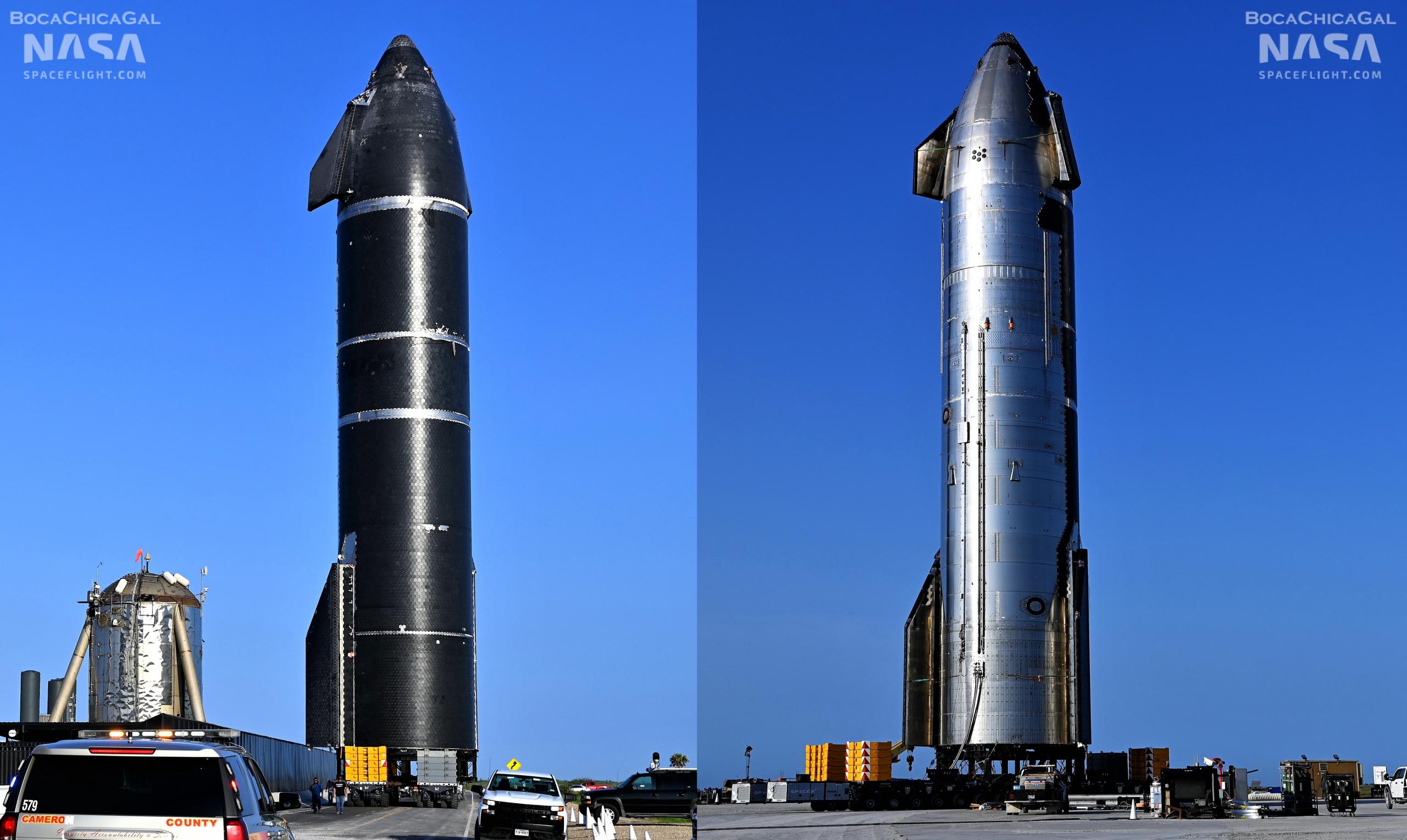
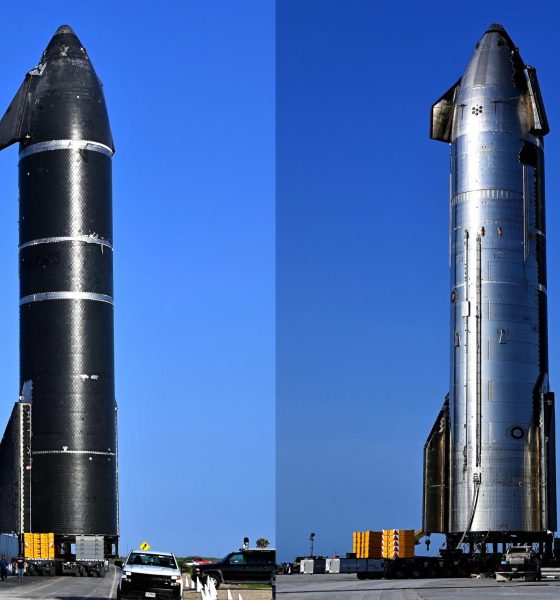
News
SpaceX rolls out first new Starship prototype in nine months
For the first time in more than nine months, SpaceX has rolled a new Starship prototype to its Starbase, Texas launch facilities in the hopes of kicking off qualification testing in the near future.
The new activity exemplifies just how different – and more subdued – Starbase’s last year has been compared to the year prior. However, it also signals new hope for a significantly more eventful 2022 as SpaceX once again finds itself preparing for Starship’s first orbital launch attempt – albeit with an entirely different rocket.
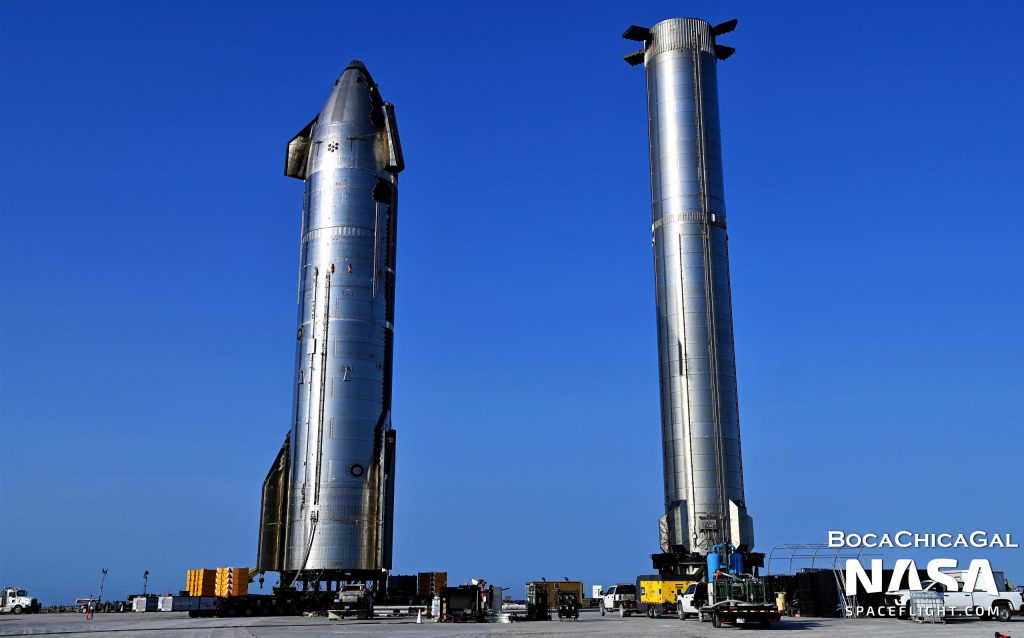
The last time SpaceX rolled a new and functional Starship prototype from the factory to the test stand was on August 13th, 2021, when Starship S20 was transported back to the pad for the second time that month. On August 5th, the same unfinished Starship was stacked on top of Super Heavy booster B4, briefly assembling the largest rocket ever built. With the luxury of hindsight, it’s now clear that that particular milestone was more of a photo-op than a technical achievement. Nonetheless, Ship 20’s path was far more productive than Booster 4’s. The Starship returned to the Starbase factory for a few days of finishing touches before arriving back at the pad on August 13th. Only in the last week of September did Ship 20 finally begin its first significant tests, followed by its first Raptor static fire in mid-October. In mid-November, Ship 20 completed the first of several successful six-Raptor static fires.
Ultimately, by the time Ship 20 was retired in May 2022, the Starship was arguably fully ready to attempt to reach orbit or at least perform some kind of ambitious hypersonic test flight. However, Super Heavy Booster 4 never made it even a fraction of the way to a similar level of flight readiness and SpaceX never received the FAA environmental approval or launch license needed for an orbital launch attempt.
Only now, in May 2022, does it finally look likely that SpaceX will finally receive the necessary permissions for a limited orbital test flight campaign in the near future. While it’s hard to say if Booster 4 and Ship 20 could have supported some kind of launch campaign if permission had been granted months ago, what’s clear is that all aspects – flight hardware, pad hardware, and bureaucracy – have been chronically delayed to the point that Booster 4 and Ship 20 are now heavily outdated.
In their place, now, stand Super Heavy B7 and Starship S24 – the new ‘chosen ones’ assigned to Starship’s orbital launch debut. Both feature extensive design changes and account for an upgraded version of the Raptor engine and countless lessons learned over the better part of a year spent troubleshooting and testing their predecessors. While it did get off to a rocky start, Booster 7 has already completed several cryogenic proof tests and is in the middle of being outfitted with 33 new Raptor engines.
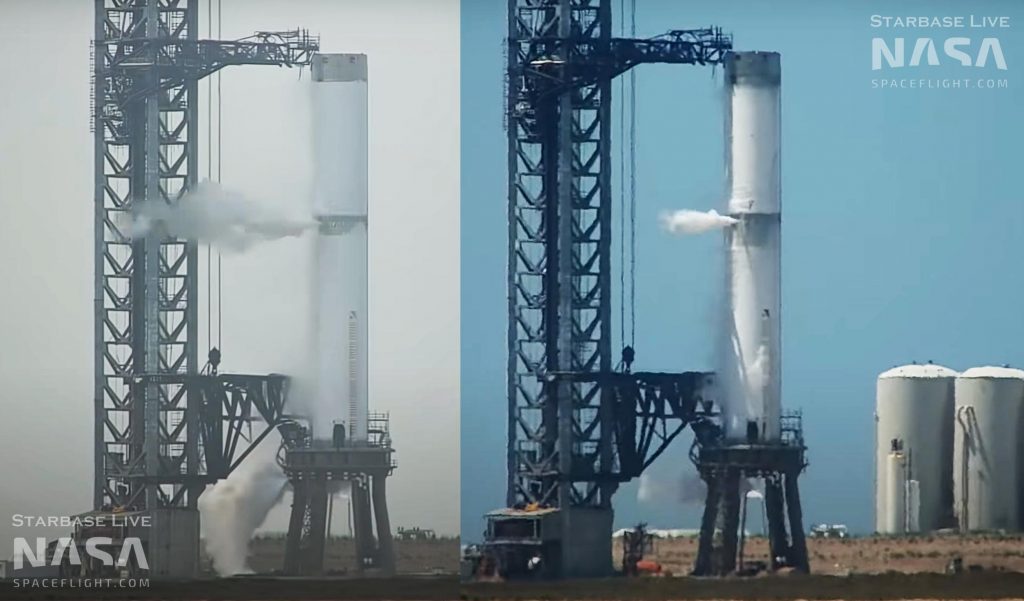
On the other hand, perhaps indicating SpaceX’s satisfaction with Ship 20’s performance, Starship S24 has been on the back burner in comparison. Only on May 26th, 2022 did SpaceX finally finish the prototype to the point that it was ready to begin qualification testing. Missing hundreds of TPS tiles and an aerocover cap, Ship 24 was quickly moved into position at a sort of drive-by test stand where it appears the prototype will first need to pass basic pressure and cryogenic proof tests.
If it passes those tests, SpaceX will then install Ship 24 on a suborbital launch and test stand (Suborbital Pad A) that has been significantly modified for qualification testing. Rather than leaping straight into static fires, SpaceX will minimize the risk of catastrophic failure by first using hydraulic rams to simulate the thrust of six Raptor V2 engines while Starship’s steel tanks and plumbing are chilled to cryogenic temperatures. Only after Ship 24 completes stress testing will SpaceX install new Raptor engines and prepare to replicate Ship 20’s success with several static fires.
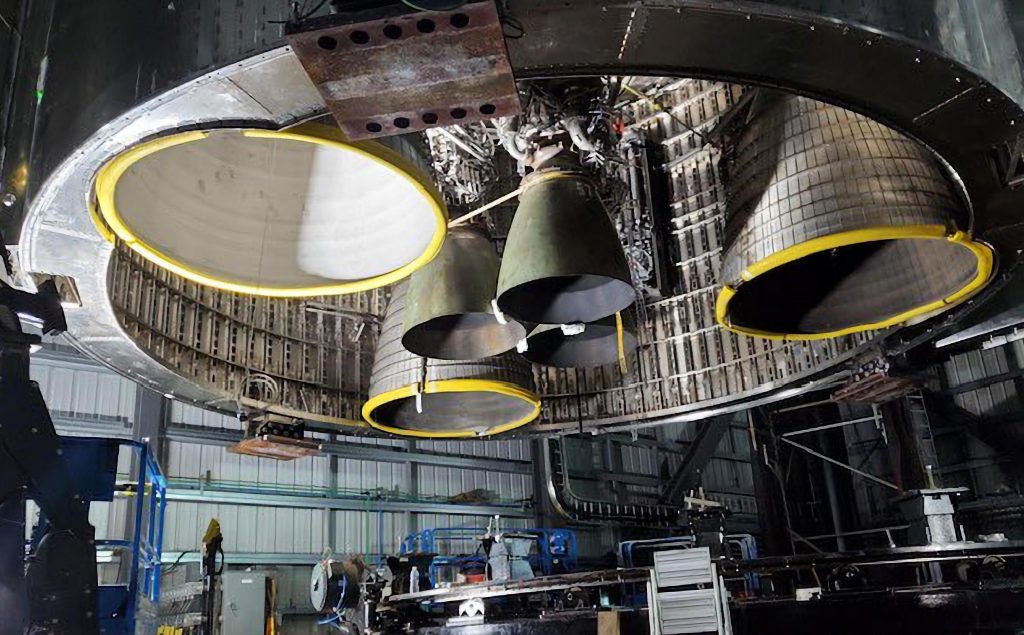
Thanks to Raptor V2’s improvements, Ship 24 will likely need to withstand around 1400 tons (~3.1M lbf) of thrust at liftoff – almost 25% more than Ship 20 ever experienced. Beyond a sturdier thrust section, Ship 24 is also the first Starship SpaceX has outfitted with a next-generation nose; the first with a significant landing propellant (‘header’) tank redesign; and the first with a potentially functional payload bay and door.
Assuming Ship 24 passes all planned cryoproof and thrust simulation tests, it remains to be seen if SpaceX will return the Starship to Starbase factory facilities or – like with Ship 20 – install Raptors and finish its heat shield and thermal protection while sitting on the test stand. SpaceX has two test windows currently scheduled: one from 6am to 12pm CDT on Friday, May 27th and the other from 10am to 10pm CDT on Tuesday, May 31st.

News
Tesla FSD fleet is nearing 7 billion total miles, including 2.5 billion city miles
As can be seen on Tesla’s official FSD webpage, vehicles equipped with the system have now navigated over 6.99 billion miles.

Tesla’s Full Self-Driving (Supervised) fleet is closing in on almost 7 billion total miles driven, as per data posted by the company on its official FSD webpage.
These figures hint at the massive scale of data fueling Tesla’s rapid FSD improvements, which have been quite notable as of late.
FSD mileage milestones
As can be seen on Tesla’s official FSD webpage, vehicles equipped with the system have now navigated over 6.99 billion miles. Tesla owner and avid FSD tester Whole Mars Catalog also shared a screenshot indicating that from the nearly 7 billion miles traveled by the FSD fleet, more than 2.5 billion miles were driven inside cities.
City miles are particularly valuable for complex urban scenarios like unprotected turns, pedestrian interactions, and traffic lights. This is also the difference-maker for FSD, as only complex solutions, such as Waymo’s self-driving taxis, operate similarly on inner-city streets. And even then, incidents such as the San Francisco blackouts have proven challenging for sensor-rich vehicles like Waymos.
Tesla’s data edge
Tesla has a number of advantages in the autonomous vehicle sector, one of which is the size of its fleet and the number of vehicles training FSD on real-world roads. Tesla’s nearly 7 billion FSD miles then allow the company to roll out updates that make its vehicles behave like they are being driven by experienced drivers, even if they are operating on their own.
So notable are Tesla’s improvements to FSD that NVIDIA Director of Robotics Jim Fan, after experiencing FSD v14, noted that the system is the first AI that passes what he described as a “Physical Turing Test.”
“Despite knowing exactly how robot learning works, I still find it magical watching the steering wheel turn by itself. First it feels surreal, next it becomes routine. Then, like the smartphone, taking it away actively hurts. This is how humanity gets rewired and glued to god-like technologies,” Fan wrote in a post on X.
News
Tesla starts showing how FSD will change lives in Europe
Local officials tested the system on narrow country roads and were impressed by FSD’s smooth, human-like driving, with some calling the service a game-changer for everyday life in areas that are far from urban centers.

Tesla has launched Europe’s first public shuttle service using Full Self-Driving (Supervised) in the rural Eifelkreis Bitburg-Prüm region of Germany, demonstrating how the technology can restore independence and mobility for people who struggle with limited transport options.
Local officials tested the system on narrow country roads and were impressed by FSD’s smooth, human-like driving, with some calling the service a game-changer for everyday life in areas that are far from urban centers.
Officials see real impact on rural residents
Arzfeld Mayor Johannes Kuhl and District Administrator Andreas Kruppert personally tested the Tesla shuttle service. This allowed them to see just how well FSD navigated winding lanes and rural roads confidently. Kruppert said, “Autonomous driving sounds like science fiction to many, but we simply see here that it works totally well in rural regions too.” Kuhl, for his part, also noted that FSD “feels like a very experienced driver.”
The pilot complements the area’s “Citizen Bus” program, which provides on-demand rides for elderly residents who can no longer drive themselves. Tesla Europe shared a video of a demonstration of the service, highlighting how FSD gives people their freedom back, even in places where public transport is not as prevalent.
What the Ministry for Economic Affairs and Transport says
Rhineland-Palatinate’s Minister Daniela Schmitt supported the project, praising the collaboration that made this “first of its kind in Europe” possible. As per the ministry, the rural rollout for the service shows FSD’s potential beyond major cities, and it delivers tangible benefits like grocery runs, doctor visits, and social connections for isolated residents.
“Reliable and flexible mobility is especially vital in rural areas. With the launch of a shuttle service using self-driving vehicles (FSD supervised) by Tesla in the Eifelkreis Bitburg-Prüm, an innovative pilot project is now getting underway that complements local community bus services. It is the first project of its kind in Europe.
“The result is a real gain for rural mobility: greater accessibility, more flexibility and tangible benefits for everyday life. A strong signal for innovation, cooperation and future-oriented mobility beyond urban centers,” the ministry wrote in a LinkedIn post.
News
Tesla China quietly posts Robotaxi-related job listing
Tesla China is currently seeking a Low Voltage Electrical Engineer to work on circuit board design for the company’s autonomous vehicles.

Tesla has posted a new job listing in Shanghai explicitly tied to its Robotaxi program, fueling speculation that the company is preparing to launch its dedicated autonomous ride-hailing service in China.
As noted in the listing, Tesla China is currently seeking a Low Voltage Electrical Engineer to work on circuit board design for the company’s autonomous vehicles.
Robotaxi-specific role
The listing, which was shared on social media platform X by industry watcher @tslaming, suggested that Tesla China is looking to fill the role urgently. The job listing itself specifically mentions that the person hired for the role will be working on the Low Voltage Hardware team, which would design the circuit boards that would serve as the nervous system of the Robotaxi.
Key tasks for the role, as indicated in the job listing, include collaboration with PCB layout, firmware, mechanical, program management, and validation teams, among other responsibilities. The role is based in Shanghai.
China Robotaxi launch
China represents a massive potential market for robotaxis, with its dense urban centers and supportive policies in select cities. Tesla has limited permission to roll out FSD in the country, though despite this, its vehicles have been hailed as among the best in the market when it comes to autonomous features. So far, at least, it appears that China supports Tesla’s FSD and Robotaxi rollout.
This was hinted at in November, when Tesla brought the Cybercab to the 8th China International Import Expo (CIIE) in Shanghai, marking the first time that the autonomous two-seater was brought to the Asia-Pacific region. The vehicle, despite not having a release date in China, received a significant amount of interest among the event’s attendees.








